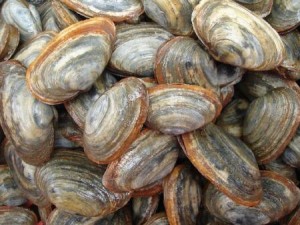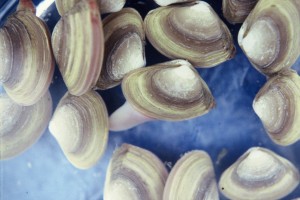 Soft shelled clams, Mya arenaria, are produced by the millions each year and raised in the hatchery until large enough for interim transplantation. Ultimately they will be used to re-seed clam flats.
Soft shelled clams, Mya arenaria, are produced by the millions each year and raised in the hatchery until large enough for interim transplantation. Ultimately they will be used to re-seed clam flats.
Hatchery personnel teach the general public, town shellfish committees, and clammers about the life cycle of clams and clam flat management. Seeding a depopulated clam flat involves transplanting young clams to traditionally productive areas that now have low clam populations due to overharvesting by humans; natural predation by birds, fish, crabs, moonsnails, sandworms, bloodworms; or poor recruitment. The seeded area is covered with nets to keep out predators, and the transplanted clams are left to grow until they reach market size. Clammers benefit from this management strategy.

In recent years, DEI and industry researchers have been collaborating to evaluate of the aquaculture potential of Arctic surfclams, Mactromeris polynyma (shown right) for culture in eastern Maine waters. The hope is that this tasty, cold water clam may one day be commercially cultured in Maine’s colder waters.
